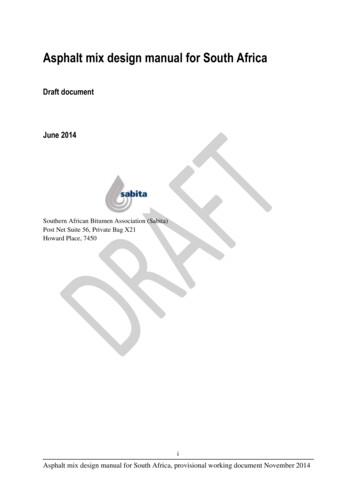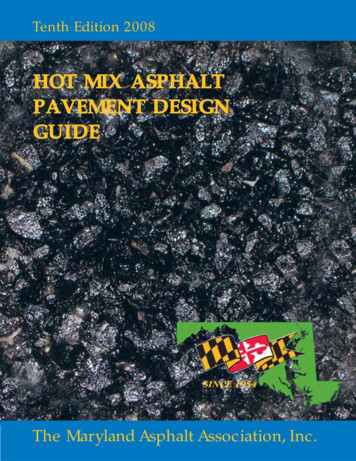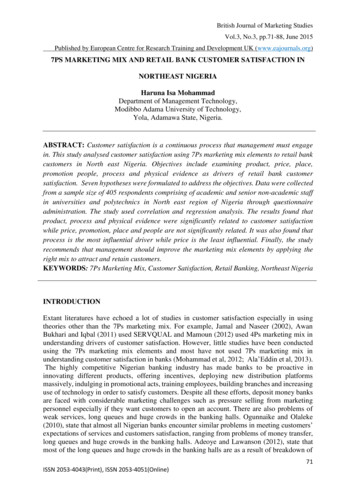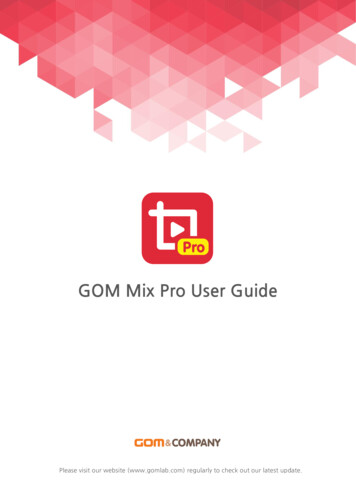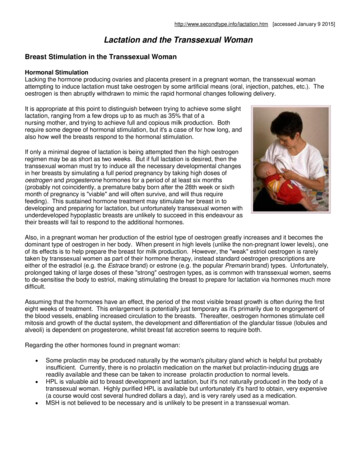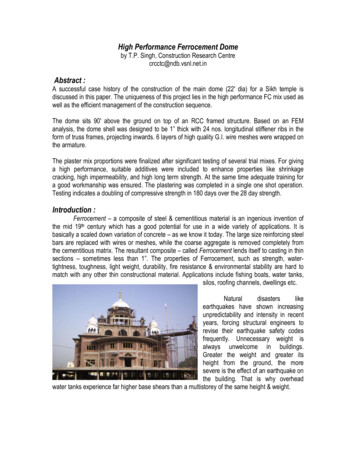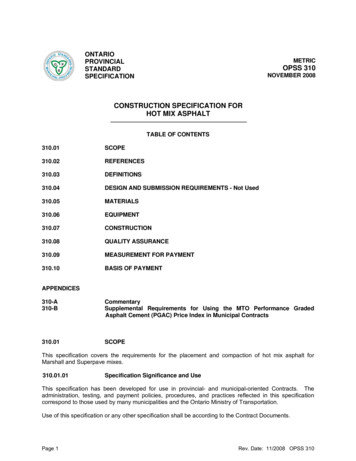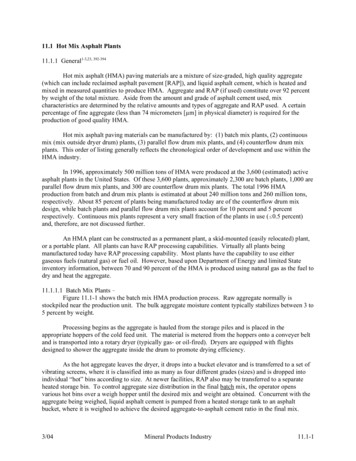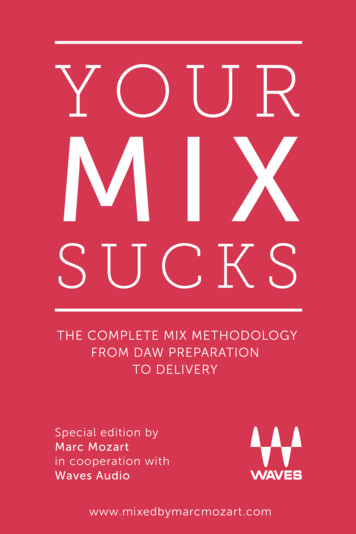
Transcription
126Special edition byMarc Mozartin cooperation withWaves Audiowww.mixedbymarcmozart.com
FOREWORD TO THIS SPECIAL EDITION226The first edition of this book was written in 2014. It wasfollowed by mix templates and channel strip libraries foryour DAW that contain all the principles, signal chains andmethods used in this book (MIX TEMPLE PRO). I’ve beena Waves-user since 1995, and the majority of the pluginsI’m using these days are still from Waves, so obviously oneof the most common questions I have received over theyears was:"Which Waves plugins do you recommend I should use?"I am extremely honored and happy to collaborate withWaves on this special edition of my bestseller. Waves isthe company that made audio plugins popular and widelyaccepted. They have defined an entire category and keeppushing the boundaries. For these reasons, this book isa complete package by delivering plugin examples andrecommendations for the various applications throughoutthe book chapters. Special thanks to Mick Olesh, OranMoked, Yotam Livny and the entire Waves-team!
INTRODUCTION326Strategically planned as this book might look, it startedout by many of my friends asking me the following or asimilar question almost every day:"Hey Marc, you know I’ve been doing this for a while.I’m really happy how my songs turn out, and I’ve come along way as a producer. But to be totally honest: my mixsucks. Do you have any basic advice how I can improvemy mixing?"The content of this book is the full version of what Iwould say on such occasions. Many people still reckonthat mixing is "turning knobs ’til booty shakes" or "somelevels, compression and EQ, until it all sounds right".In this book, we explore things a little moresystematically. We talk about cause and effect, whythings have to be done in the right order, and what pathto work your way through to a great mix. The solutionlies in the process and the order in which you sort outthings.If you don’t have a methodology, your mix cansuffer from a severe "domino effect". Which of courseis an analogy for one bad decision triggering a seriesof follow-up effects, and while you’re working towardsfinishing your mix, what started as a small problemwill accumulate and get worse. For example: A badlistening environment will inevitably lead to wrongmixing decisions that you'll be busy correcting all theway through - instead of really focusing on the actualcreative elements of mixing. You’re getting all frustratedabout the outcome of your mix, while in reality, you hadno chance getting it right under the given circumstances.
Later on, when you check your mix in the car, in a club,or even at the mastering studio, it’s too late. I fully trustthat you have the ears to hearing something is wrongwith your mix, but your problem has gotten out ofhand with a series of follow up decisions based on thewrong assumptions. A good methodology helps to avoiddomino effects by dealing with fundamental problemsfirst. It's also supporting your creativity and intuition,because all of a sudden you’re not putting out fires allthe time, you’re making real progress.426
01020304050607Monitoring, Loudness & Your Ears Steal Mom's Kitchen Radio From Small Window To Magnifying Glass Listening Levels Switching SpeakersCreating The "Good Enough" Mix Room Room Acoustics – Ghetto Style Speaker Setup, Absorbers & Bass Traps Improving The Low End Of Your Room The 10-Minute Room TestPreparing Your Mix Session Micro- & Macro-Management Of Your Mix Importing The Files The Concept Of "Handles" References And A/BingThe Magic Of The 1st Listen The 1st Listen Experience Mixing For Someone Else Emotional And Analytical Listening Mixing Your Own SongFoundation: Kick, Bass & Gain Staging Low end Analysis And Balance Shaping Kicks, Mixing Bass Drum Replacement Gain StagingIt’s All About The Vocals A Quick Excursion Into Vocal Recording Building The Lead Vocal Chain Parallel Compression Vox Against The WorldContinuity Correcting Levels Pre-Plugin Chain Careful Limiting Nulling Your Faders526
08091011121314Parallel Compression The Theory Behind Parallel Compression The Philosophical Dimension Parallel Compression On Vocals and Drums Parallel Compression PluginsColors & Dynamics EQ-ing and EQ-Plugins A Different Look At Compressors Compressor-Plugins Tape Saturation, Mic Pres and Magic ChainsDimension & Reverb Culture Reverb History A 3-Dimensional Mix Flavors Of Delays Modulation, Subgroups, FX-Busses and RoutingAutomation & Stereo Bus Magic Automation Stereo Bus Magic Loudness Meter Useful Mix Bus PluginsStems, Mastering & Delivery Feedback Printing Stems & Archiving Mastering DeliveryBonus I: SSL Consoles - History & Typology Overview History Today ResourcesBonus II: Notable Waves Plugins Sound Shifter Pitch & Waves Signature Series Selected Reverbs & Waves OneKnob Series The Renaissance Plugins & Unique Tools626
THIS IS AN EXCERPT TAKEN FROM CHAPTER06 OF THE E-BOOK: "YOUR MIX SUCKS" WAVES EDITIONIT'S ALL ABOUT THE VOCALSOnce we have created a frame for our mix asdescribed in chapter 5, it’s time to focus on thevocals - in many cases the most important instrumentin the mix.The human voice is the most complexinstrument we have to deal with, and in the following, I’llintroduce you to the important aspects of dealing withvocals in a mix.726
VOCAL RECORDING - PREPARATION826I know this is not directly related to mixing, but a greatvocal performance and recording is the best foundationfor a quality vocal in the mix - so if you’re in charge ofvocal production, here are some ideas for you.Getting this right can save you a lot of work in the mix!1. GET THE SINGER TO DOA VOCAL WARM-UPThere are some great vocal warm-up programs outthere. Just do a search on YouTube for "vocal warm up"and you’ll find lots of options. The warm up should takeat least 30 minutes, a full hour is even better. A goodwarm up has a slow build, and consists of a big variety ofnotes, expressions and phrases.Trust me, it’s worth it and will save you hours invocal recording. It’s basically like sports - no professionalathlete would ever skip preparation and warm up! Myfavorite vocal warm up is by Stevie Lange - on herwebsite you can find female and male versions.2. GET THE SINGER TO DRINKLOTS OF STILL WATERIn addition to the warm up, the singer should drink lotsof still water before and also during the session.3. PRINT OUT THE LYRICSThis will be helpful for both the producer and the singer.Type down the lyrics of the song and print 2 copies, onefor you, one for the singer. Make sure the font is largeenough so it’s easy to read. Print it on two pages if itdoesn’t fit on one.Have a music stand and a working pen readyfor the singer and also yourself, so you can both makenotes. Place the music stand and note sheet in a waythat it doesn’t reflect back into the microphone - theright angle helps wonders!
4. RECORD A COUPLE OF RUNSTHROUGH THE ENTIRE SONGI know – recording vocals in sections is very popular, butit’s still a good idea to record the entire song from startto finish at the beginning of the session. Mainly becauseit gives you a better idea of the macro dynamics of thesong.When recording a song in sections, you caneasily overpower the first verse, then realize the singercan’t top the power in the chorus. So make sure todefine the tone and power of each section during theserun-throughs.5. RECORD THE SONG IN SECTIONSIf the complete runs went very well, this is just a backup,but the reality is that most vocals are recorded insections. Loop a song part (e.g. verse or chorus), makesure to have 2 - 4 bars pre-roll of just music betweenevery take and just keep recording.You will probably see the performance improvewith every new take until at one point the quality dropswhich is when you should stop and go to the nextsection. Once you went through all the sections, youshould start at the first section again because there waslikely a development in quality, and this second sessionis usually a huge improvement over the first one.6. HOW MANY TAKES?The number of takes you want to capture varies - thereis no rule to that. I’ve worked with professional sessionsingers in New York that were so well prepared that 3takes was all I’ve ever needed. In the 2000s, I’ve workedwith a lot of young and inexperienced casting TV showartists (Idol, X-Factor, The Voice), where I would recorda minimum of 10 - 20 takes of each section. You haveto decide it from case to case, but keep in mind thatsometimes, this one vocal session is your only chanceto get it right, and better be safe than sorry!926
VOCAL RECORDING WHAT TO AVOIDNow on to the more technical aspects of vocal recording- here are some of the biggest issues I see:1. TOO MUCH TREBLE AND "ESSES"Vocal sounds are a matter of trends. For years, the SonyC800G tube microphone has been very popular due toits emphasis and fine resolution on higher frequencies.Without a doubt, one of the best mics ever made, butat the same time, depending on the type of vocal, theremight be excessive sibilance on the vocal-tracks.A mic that emphasizes the highs is not the mainsource of trouble here - its excessive sibilance pushedinto a tracking compressor that creates the problem.For this reason, I don’t recommend a tracking compressorwhen trying to achieve a vocal sound with crisp highs.Along with more organic productions, recentyears brought back more natural, organic-soundingvocals, with less emphasis on the highs.Another positive development for musicproducers is that the market for affordable studio mics isgrowing and changing. Classic microphone designs aregetting very affordable, costing a fraction of the priceof 10 years ago, and the latest trend of DSP-modeledmicrophones is already giving us a glimpse into thefuture.2. NO POP SHIELDIf you don’t use a pop shield in front of your vocal mic,chances are you will literally have dropouts in youraudio signal. Not every pop shield sounds the same - it’sdefinitely worth having a few different ones at hand andlisten to the difference.1026
3. RECORDING IN A VOCAL BOOTHMost small home-made vocal booths are not properlyabsorbing ( reducing reverb-time of the room) thesound across the entire frequency spectrum. All theydo is dampening the highs, leaving you not only with aboomy sound, but also with comb-filtering that resultsin resonances across the mids.Vocals sound better recorded in larger rooms,and it is a lot easier to deal with a few more reflectionsfrom a large room than removing resonances fromcomb-filtering.Of course, an ideal environment is spacey ( lots of space between the singer and the next hardwall) and absorbing at the same time. If you have anacoustically treated control room, try recording thevocals there. Movable acoustic panels (aka GOBOs)can be very helpful as well. I usually record vocals inmy large control room while putting the GIK AcousticPIB (Portable Isolation Booth) around the back of themicrophone.Our portable acoustic booth by GIK Acoustic1126
4. USING A TRACKING COMPRESSORAgain, if in doubt, don’t use a tracking compressor – it’sa habit from the analog tape tracking age, where highrecording levels where the treat against the ever existingnoise floor of tape. In a digital 24bit world, set your micpre and tracking levels carefully, and make sure you haveplenty of headroom even during the loudest vocal partsof the song.A high quality mic pre and A/D converter can bea good investment, but to be fair, even lower priced USBaudio interfaces provide lots of dynamic in 2019.VOCAL TUNINGFor me, tuning vocals is part of fixing the performanceand I’m not a big fan of it as part of the mixing process. Itcan take a lot of time and attention away from getting themix right in a macro, but since it’s technically possible,it’s part of our repertoire of tools.The Waves Tune Real-Time Vocal Tuning Plugin1226
1326The Waves Tune: When you need total controlHere are some basics on using tuning plugins in a mix:1. Basic SetupOnce more, you need to know the key of the song you’remixing and the exact notes covered by the vocals. Everytuning plugin has a setting for the song-key. Setting thesong-key to "chromatic" works in theory, but can createnotes that are completely wrong.Also, it’s not enough to set the key to C minor,when both B and Bb are possible notes depending on thecontext of the chord progression. Then, there’s songsthat modulate between different keys, in that case it’sgood to have separate vocal tracks for these sections.Once you have set the correct key, the setup is straightforward for most pop-songs or similar genres.2. Automating Speed / Response TimeVocal tuning plugins always have a speed-setting thatdetermines the speed in which a note will be tuned.When it’s set fast, you get that classic FX-sound, butwhen set to a slower value, the tuning plugin can be
very subtle as the plugin takes a long time to "bend" thetone to the target note, just like a good singer would donaturally. There’s definitely a setting with a long speedtime that makes vocal tuning completely unnoticeable.The next step is to draw the speed in the automation ofyour DAW.If there’s a note or phrase that needs tuning,you just automate the speed to a faster value. Theautomation curve you’re using to go from slow to fast isthe factor for how much you hear side-effects of tuning.Automation curve on the Waves Tune Real-Time Vocal TuningPluginI am of course assuming that you want the vocal tosound natural, with no side-effect. When using tuningplugins, avoid having all doubles of the same vocal-linetuned. Especially on a backing vocal, if you have twodoubled takes, only tune one of them. If you have morethan two, only tune half of them, and between the tunedones, fine-tune them against each other (for example:left BV at -5 cent, right BV at 5 cent).3. Vocal CompingAnother trick that needs to happen at production stageis having the tuning plugin in your monitor chain whilecomping the vocal takes from your recording session.That way, you can choose to not select takes that havenoticeable side-effects /artefacts from the tuning plugin.1426
BUILDING THEL E A D V O C A L- C H A I NAll of the following, please do at a low listening level.I tend to use my small portable stereo-speakers (aka"kitchen radio") for that and start by leveling theuntreated lead vocal so that it sits a little low in the track,just loud enough so you can understand the lyrics andfollow the melody.Let me make an important statement – and I’llsay this a few more times in the book: keep going backbetween these different building blocks for fine-tuning!Just as an example, you will need to re-adjust thesibilance once you’ve added the final "attitude"compressor. That goes for each building block. Go backand forth between the building blocks and re-adjust.Also, watch your gain staging - makesure the input level at each building block is similar tothe output level. This chain has 3 dynamics processorswith EQs in between, they are kind of "sharing" theworkload of making the vocal sit tight in the mix. Noneof these building blocks need to do the "heavy lifting" ontheir own, each has their own role, and less is more.Bypassing one or more building blocks is alwaysan option. Many times you don’t need all of them!Before I go through the chain, I’d like to again stress theimportance of sending the correct level into the pluginchain. Start with an average (RMS)-level of -18dBFS here(that’s the scale in your DAW). If your recording is louderthan that, lower it using a gain plugin.1. CONTINUIT YStarting with the untreated, "naked" lead vocal-track,I want you to first understand the concept of havingtwo types of volume automation on a vocal: before theprocessing chain, and after it.1526
This first one evens out the performance of the singer.You could say it creates the continuity of levels in thevocal that you wished the singer had delivered in the firstplace. This is something that overlaps and goes back tomix preparation, and there is a fair chance that this isalready in a good place. To confirm this, run the mix, gothrough the song from start to end and find spots wherephrases or syllables of the lead vocals drop in level, orjump out considerably. Correct these phrases in wholedB-values - in other words, don’t go too much intodetail, don’t draw complex automation curves etc., thisis just one small step to even out the lead vocal acrossthe song. Waves has a plugin called Vocal Rider that cando the job. You can set a target-level for the vocals anddepending on the speed-setting (fast or slow) it will keepyour levels steady and gets very close to an engineerriding the faders manually. Make sure the output levelstays at around -18dBFS - this goes for the output of allplugins in this chain.The Waves Vocal Rider Plugin1626
2. SIBIL ANCEDo you feel the sound of the vocal leans towards toomuch sibilance? Time to use a De-Esser, which is aspecialized compressor that has an EQ in the sidechain.A De-Esser can reduce the level of syllables that have toomuch treble (typically between 5-12kHz). The frequencythat you want to reduce can usually be set in the plugin,as well as the threshold (minimum level at which it startsworking) and the amount of reduction in dB. You canuse an analyzer to find out at which frequencies the"Esses" are jumping out.Alternatively, reducing the sibilance pre pluginchain is a more precise way to do this. In that case, Iisolate the "Esses" to their own regions which I drag toa separate track but same channel strip (so I can selectall "Esses" at the same time). I reduce the gain on theseregions between 6dB - 10dB, depending on how muchthe vocal gets compressed in the mix. You want toset them low enough to run below the compressor/sthreshold (If this is new to you, we'll talk about this inchapter 9).If you can't get a De-Esser to achieve the same- use this technique! You can also completely isolate"Esses" to another channel strip and EQ/compress themdifferently. Same goes for breathing noises.Waves has developed a total of 3 distinctlydifferent De-Essers over the years, all of which can beuseful depending on the situation. The latest WavesSibilance plugin will cover you in all of these situations.The original Waves DeEsser in "Wide" mode hasbeen my "go to"-plugin for many years when I don’twant the De-Esser to manipulate the sound. In "Wide"mode, the De-Esser is just reducing the level, every timesibilance is occurring at the selected frequency. It’s veryquick and intuitive to dial in, and has a split mode as wellwhich reduces sibilance at just the specific frequencies.1726
The Waves Renaissance DeEsser does a similar thing,but has a slightly different vibe to it - I like the way itsmoothens out the sound of the "Esses" in "Split" Mode.The Waves Renaissance DeEsser PluginThe Waves Sibilance is their latest De-Esser, basedon the Waves Organic ReSynthesis engine. It has themost variable and flexible settings including a crossfader that can mix between wide and split-mode, veryvariable detection of sibilance and separate controls forthreshold and range.The Waves Sibilance Plugin1826
3. WARMTHWith the vocal sitting a little low in the track, we nowneed to develop a feeling for what’s missing. We do thatby adding frequencies using EQs, starting from the lowmids.The Waves PuigTec MEQ5 - The "Midrange Equalizer" ismodeled after an original 1950s Pultec MEQ-5A. Broad boost between 200Hz and 500HzThe Waves PuigTec Midrange Equalizer MEQ 5 is usuallymy first EQ in the vocal chain, but you can simulatethese (broad) curves with many other EQs. I don’t evergo lower than 200Hz, and occasionally up to 700Hz.The effect we want to get here is that the vocalgets more weight and warmth in the mix. If the vocalis well tracked, it comes with a lot of that quality in therecording and you may not need to do anything here.This is why people use various transformer ortube-based equipment (from Mics to EQs/Compressors)during tracking.However, a lot of modern vocal recordingssound rather thin, and a nice boost in the low mids canhelp that! If you like the character you’re adding with theboost, you can even do a little bit too much of it.We can then counterbalance that in the nextsteps. In case the vocal already sounds overly "muddy" or"boomy", add an EQ plugin like F6 RTA at the beginningof the plugin chain, locate and remove the frequenciesthat cause this effect. Watch the interdependence ofthat - once you’ve removed resonances, you have moreleeway to use that broad Pultec-boost again.1926
You really can’t go wrong with a Pultec, but there are ofcourse other EQ emulations that do a similar job. We arelooking at more EQ models in chapter 9.B. Tube compressor for toneAfter the boost, insert a compressor for tone - we are notafter compression for level automation here, but want toadd harmonics on top of the low mid boost and create asense of glue. The classic Fairchild 660/670 (available byWaves as PuigChild Compressor) works great here, butdon’t limit yourself - many compressors can do the job.Just make sure the compression is very subtle.A compressor after an EQ boost works so wellbecause the two components interact. The more youboost a specific frequency, the more compression willbe applied to that frequency. So the two balance eachother out, which makes that combo very organic. Lighttape saturation can also work here - and we are takinga closer look at more classic compressors in a laterchapter!The Waves PuigChild 660 is modeled after a rare FairchildCompressor (The picture shows the mono version which iscalled 660, the stereo version is called 670)2026
4. PRESENCEIn a dense mix, this is were we create the frequencies thatmake the vocal cut through the rest of the instruments.We can go to extremes here, but before you start playingwith the mid boost, set up the "attitude" compressor thatfollows it right away. It’s needed to tame the mid boostsas they can get very harsh.Often, less or no boosting in the mids is neededin less populated parts of the song, but when the vocalsare up against a wall of sound, you will need a musicallycomposed texture of "cut through" frequencies there.Various boosts between 1kHz and 8kHz (SSL EQ)This is more complicated to get right, compared tocreating warmth. Start with a SSL-type EQ and boost thehigh shelf at 8kHz 10dB, then pull back again to 0dBand find a great setting for it somewhere in the middle.Try switching between bell and shelf characteristics (bellwill just boost around the set frequency, while shelfalso includes all frequencies above.) If 8k is boostingsibilance too much, go a tiny bit lower.Continue by using the HMF band to boost at 4k.And the LMF to boost 2kHz. Move these around until youfind a good balance - but keep in mind, not boostinganything is always an option. The goal is to create acluster of mid-boosts that really becomes one colorfuland musical texture of mid-boosts between 1kHz and8kHz. You can achieve good results with stock EQs ofyour DAW, but there is a reason why SSL EQs are famousfor their musicality in the mids. API works as well. Not ajob for a Pultec.2126
5. AT TITUDEThis compressor’s job is to tame the mid-boosts we’vejust created. We want to see it work hard and fast, but itneeds to have a lot of musicality to reduce the harshnessof the mid boosts. The classic 1176 Bluestripe hasbecome my favorite compressor for this stage and theharder you drive it, the more "attitude" you’re getting.Waves has recently introduced the (Chris Lord-Alge, justsayin') CLA MixHub which, luckily, combines both theclassic SSL EQ and the 1176 BlueStripe into one plugin.The Waves CLA MixHub6. FINAL TONE AND DYNAMICS CONTROLA. EQA final EQ can round off highs and mids. I like the WavesPuigTec EQP-1A here, to boost at 20Hz, and attenuate at20kHz. This plugin is modeled after the legendary 1950sPultec EQP-1 tube equalizer. Your vocals will soundmore analog when you roll off the top end slightly.2226
Both the boost at 20Hz, and the attenuation at 20kHzshould not affect the essence of the tone you havecreated. The boosts can add little bit of weight, andthe cut removes top end energy that only hurts at loudvolumes.The Waves PuigTec EQP-1AB. Brickwall LimiterYou can use a limiter at the end of the chain to catchoccasional peaks that jump out. Only catch occasionalpeaks, and set the release time higher than 100ms. Adigital brickwall limiter works well here. I happen to be afan of the classic Waves L1 in this place.The Waves L1 limiter - a classic2326
PLEASE KEEP IN MIND!The plugin chain outlined above is pretty complex.There is of course the possibility of processing thevocals too much with a signal chain like this. Whenyou want a really natural vocal sound, you might justneed 3B (the subtle tube compressor) and 6A (Pultecfor basic tone control).A natural vocal sound requires a very goodrecording though, and we rarely have an influence onthat as mix engineers. On the other hand, this pluginchain is designed to be able to deal with any type ofvocal, and when the vocal needs to cut through a densemix, processing is absolutely necessary. However,subtle settings in each plugin can still cumulate in adrastic overall effect, while retaining a natural tone.2426
HI THERE!2526Thanks for stopping by – my name is Marc Mozart, mixengineer, award-winning music producer and director ofthe social media- and music agency "Mozart & Friends".I grew up in a musicians family, recorded and mixedmusic since my early childhood, cutting reel to reel-tapewith a razor-blade, and got my first major breakthroughin Frankfurt during the rise of German Techno andEurodance-Music in the early 1990s. Later on, I spenttime in New York, worked and teamed up with variousA&R-managers and producers from P.Diddys “Bad Boy”camp as well as Izzy Zivcovic, who later on managedKanye West. In the 2000s, together with the Mozart &Friends-team of music producers and songwriters,I have produced, written and remixed more than70 charting bestsellers around the world. This includesNo. 1 singles and albums which received multiple gold/platinum awards. In 2014, I wrote the e-book "YOUR MIXSUCKS", which is now one of the leading books of ourtime on the topic of audio mixing and mastering. In 2019I teamed up with Waves to create a special "YOUR MIXSUCKS" Waves edition.I'd like to invite you to join me on Facebook,Instagram, YouTube and LinkedIn. I am using allaforementioned channels as well as my podcasts(available in English and German language) to delivera lot of free audio mixing and social-media marketingknow-how for producers, DJs, singer/songwriters andaudio engineers. Also, all legitimate buyers of the e-bookreceive a year of free mix feedback from me - you juste-mail me your track to feedback@mixedbymarcmozart.com and I’ll come up with some quick suggestions forimprovement. Of course, you can use that same e-mailfor all sorts of feedback, questions and whatever youneed from me.Marc Mozart, August 2019
This is an excerpt from version 1.0 - August 2019 YOUR MIX SUCKS Waves edition.For support, questions and feedback,please e-mail feedback@mixedbymarcmozart.comCopyright 2014 - 2019 by Mozart & Friends UGWritten by Marc Mozart: http://www.mixedbymarcmozart.comEditing by Marc Mozart, Tobias Lichtmann, Samuel Kümmel,Simon Malz (www.lichtsignale.de), MJ Deech and Nick Hepfer Cover & Book design by Peter "Fonty" AlbertzIcons made by Vaadin from www.flaticon.comAll rights reserved. This eBook is protected by international copyright law.You may only use it if you have bought a licensed version from the waves.com ormixedbymarcmozart.com site. No part of this publication may be reproduced,distributed, or transmitted in any form or by any means, including photocopying,recording, or other electronic or mechanical methods, without the prior writtenpermission of the publisher, except in the case of brief quotations embodied incritical reviews and certain other noncommercial uses permitted by copyright law.For permission requests, write to the publisher,addressed "Attention: Permissions" at the address below:This eBook is published by:Mozart & Friends UGRiegelpfad 835392 Giessen, Germanyfeedback@mixedbymarcmozart.comAlthough the author and publisher have made every effort to ensure that theinformation in this book was correct at press time, the author and publisher do notassume and hereby disclaim any liability to any party for any loss, damage,or disruption caused by errors or omissions, whether such errors or omissions resultfrom negligence, accident or any other cause.Disclosure statement: The links in this e-book are affiliate links, meaning, at noadditional cost to you, Mozart & Friends UG will earn a commission if you clickthrough and make a purchase on the Waves.com website.Abbey Road Studios, EMI, TG, REDD, Curve Bender, RS and their assoctiated logosare trademarks of EMI (IP) Limited.BSS and dbx are trademarks of Harman international.Solid State Logic and SSL are trademarks of Solid State Logic.API is a trademark of Automated Processes, Inc.2626
I know this is not directly related to mixing, but a great vocal performance and recording is the best foundation for a quality vocal in the mix - so if you’re in charge of vocal production, here are some ideas for you. Getting this right can save you a lot of
